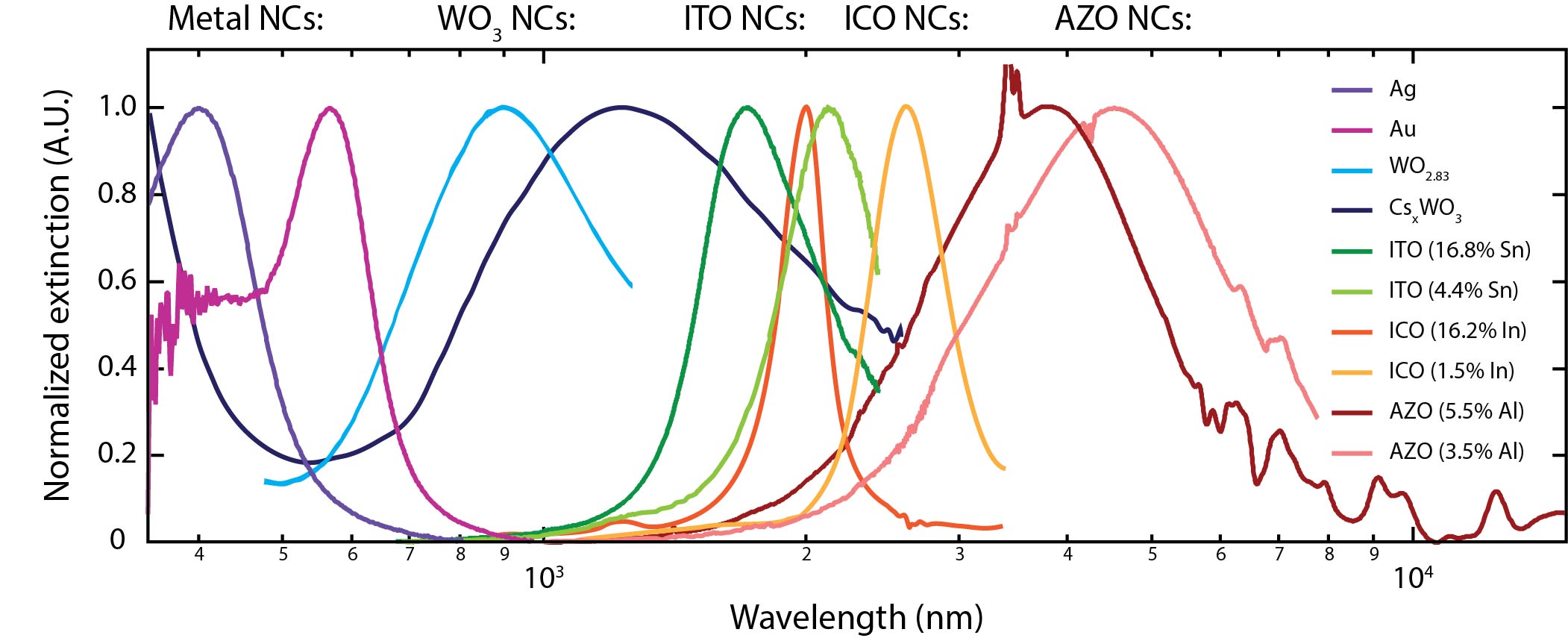
Semiconductor Nanocrystal Plasmonics

Normalized optical extinction due to LSPRs in solutions and films of metal and metal oxide nanocrystals [1].
Doped semiconductor nanocrystals with variable free carrier density can support collective oscillations of charge in response to electromagnetic radiation, exhibiting enhanced absorption through localized surface plasmon resonance (LSPR) effect. By electrochemically charging and discharging nanocrystal films, tunable IR-plasmonic electrochromism in energy saving smart window is achieved.

Na+ induces faceting during In2O3 synthesis, allowing for tunable nanocrystal morphology. (left) [6] Co-doped F,Sn:In2O3 nanocrystals are cubic with multi-modal LSPR and intense near field enhancement at the corners. (right) [3]
Our synthetic studies focus on controlling nanocrystal size, shape, composition, and defect chemistry to tune the plasmonic response. In contrast to the LSPR in metals, interstitially or substitutionally localized dopants in metal oxides provide extended LSPR tunability across the IR spectrum. For instance, we have demonstrated that fluorine induces faceting in indium oxide-based nanocrystals, leading to cubic nanocrystals with narrow, shape-dependent, multimodal LSPR arising from different cubic facets [2,3]. In addition, we found that the corner faceting of these cubic NCs has a higher sensitivity than the classical spherical NCs. [4] Surface segregation of dopants in Sn-doped indium oxide (ITO) also leads to multimodal LSPR that are tunable via shell thickness and more sensitive to their dielectric environment than uniformly doped nanocrystals [5]. Studying the effects of non-incorporative alkali cations on nanocrystal synthesis revealed that concentration of the cations present during synthesis can be used to tune the NC size whereas the cation identity alters the nanocrystal shape.[6] Furthermore, the addition of alkali cations can be also used as a synthetic strategy for material’s defect engineering. [7]

Fitting the plasmon resonance of ITO nanocrystals with the Heterogeneous Ensemble Drude Approximation (HEDA) provides the best fit to experimental data while also calculating intrinsic electronic parameters. (left) [10] Chemical redox agents such as CoCp*2 drastically change the absorption of ITO nanocrystals, largely due to charging of the depletion layer. (right) [11]
VIS-NIR and FTIR spectroscopies are experimental techniques often used to characterize the plasmonic behavior of nanocrystal ensembles [8]. These experimental methods can be coupled with multi-scale theoretical models (e.g., Drude models) and simulations to coordinate the design of new materials with targeted LSPR properties. For example, post-synthetic LSPR modulation is achievable in ITO nanocrystal ensembles by tuning the carrier density via electrochemical charging, shedding light on the impacts of surface depletion layers on LSPR modulation [9]. The effects of surface depletion in doped metal oxide nanocrystals are further elucidated with the development of the heterogeneous ensemble Drude approximation (HEDA), a mathematical Drude fitting model used to fit experimental optical spectra which enables the analysis of intrinsic NC properties from an ensemble measurement [10]. In the case of post-synthetic LSPR modulation via redox reagents, the HEDA model offers fundamental insights into individual electron-transfer events and how surface depletion governs such electron-transfer processes [11]. Understanding the complex factors, either synthetic or post-synthetic, that impact the dynamic control of the LSPR offers a unique opportunity to further develop novel photonic systems and optoelectronic devices.
Related papers:
[1] A Agrawal, SH Cho, O Zandi, S Ghosh, RW Johns, DJ Milliron. “Localized Surface Plasmon Resonance in Semiconductor Nanocrystals,” Chem. Rev., 118 (2018), 3121–3207 [link]
[2] SH Cho, S Ghosh, ZJ Berkson, JA Hachtel, J Shi, X Zhao, LC Reimnitz, CJ Dahlman, Y Ho, A Yang, Y Liu, JC Idrobo, BF Chmelka, DJ Milliron. “Syntheses of Colloidal F:In2O3 Cubes: Fluorine-Induced Faceting and Infrared Plasmonic Response,” Chem. Mater., 31, (2019), 2661-2676 [link]
[3] SH Cho, KM Roccapriore, CK Dass, S Ghosh, J Choi, J Noh, LC Reimnitz, S Heo, K Kim, K Xie, BA Korgel, X Li, JR Hendrickson, JA Hachtel, DJ Milliron. “Spectrally Tunable Infrared Plasmonic F,Sn:In2O3 Nanocrystal Cubes,” J. Chem. Phys., 152, (2020), 014709 [link]
[4] BJ Roman, SA Shubert-Zuleta, G Shim, V Kyveryga, M Faris, DJ Milliron. “Facet-Enhanced Dielectric Sensitivity in Plasmonic Metal Oxide Nanocubes,” Nano Lett., 127, (2023), 2456-2463 [link]
[5] SL Gibbs, C Dean, J Saad, B Tandon, CM Staller, A Agrawal, DJ Milliron. “Dual-Mode Infrared Absorption by Segregating Dopants within Plasmonic Semiconductor Nanocrystals,” Nano Lett., 20 (2020), 7498-7505 [link]
[6] K Kim, LC Reimnitz, SH Cho, J Noh, Z Dong, SL Gibbs, BA Korgel, DJ Milliron. “Effect of Nonincorporative Cations on the Size and Shape of Indium Oxide Nanocrystals,” Chem. Mater., 32, (2020), 9347-9354 [link]
[7] K Kim, J Yu, J Noh, LC Reimnitz, M Chang, DM Gamelin, BA Korgel, GS Hwang, DJ Milliron. “Synthetic Control of Intrinsic Defect Formation in Metal Oxide Nanocrystals Using Dissociated Spectator Metal Salts,” J. Am. Chem. Soc., 144, (2022), 22941-22949 [link]
[8] CM Staller, SL Gibbs, CA Saez Cabezas, DJ Milliron. “Quantitative Analysis of Extinction Coefficients of Tin-Doped Indium Oxide Nanocrystal Ensembles,” Nano Lett., 19, (2019), 8149-8154 [link]
[9] O Zandi, A Agrawal, AB Shearer, LC Reimnitz, CJ Dahlman, CM Staller, DJ Milliron. “Impacts of Surface Depletion on the Plasmonic Properties of Doped Semiconductor Nanocrystals,” Nat. Mater., 17, (2018), 710-717 [link]
[10] SL Gibbs, CM Staller, A Agrawal, RW Johns, CA Saez Cabezas, DJ Milliron. “Intrinsic Optical and Electronic Properties from Quantitative Analysis of Plasmonic Semiconductor Nanocrystal Ensemble Optical Extinction,” J. Phys. Chem. C, 124, (2020), 24351-24360 [link]
[11] B Tandon, SA Shubert-Zuleta, DJ Milliron. “Investigating the Role of Surface Depletion in Governing Electron-Transfer Events in Colloidal Plasmonic Nanocrystals,” Chem. Mater., 34, (2022), 777-788 [link]